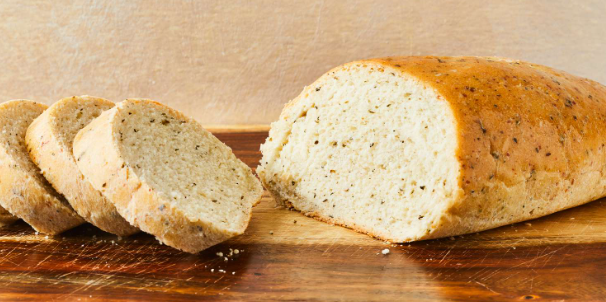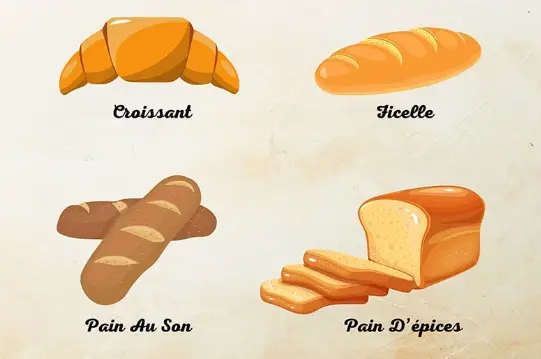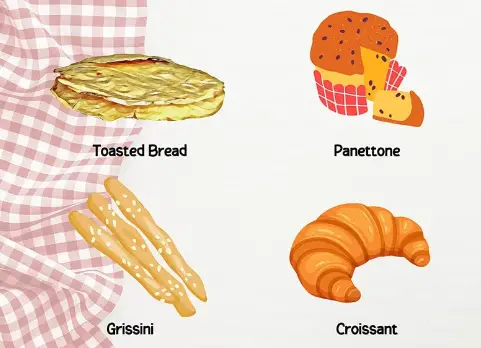The subtle, yet distinct, differences between Italian and French bread lie in their length, texture, and ingredients. French bread is typically long and narrow with a hard, crusty exterior and a light, soft crumb. In contrast, Italian bread, while it can also possess a crusty exterior, has a denser crumb and often comes in shorter, plumper loaves.
What Is French Bread?

French bread is a staple in French cuisine, known for its elongated shape, crispy crust, and light, fluffy interior. The classic French Baguette yields around 20 to 25 slices, each weighing approximately 1 ounce.
What Is Italian Bread?

Italian bread comes in a variety of shapes and sizes, often differing by region. The characteristic features of Italian bread include its crusty exterior, dense interior, and often, a rounder, plumper shape compared to its French counterpart.
French Bread vs Italian Bread: A Comparative Analysis
Geography
French bread styles are available nationwide, with regional specialties like fougasse from Provence and couronne. Italian loaves, however, vary more significantly by region, from crusty pane casareccio in Puglia and Rome, to softer, sesame-topped loaves from Sicily.
Ingredients
A key distinguishing factor lies in the ingredients. French bread uses a simple quartet of wheat flour, water, yeast, and salt, with no added oil or fat. On the other hand, Italian bread often contains milk or olive oil, and sometimes a dash of sugar.
Shape
French bread is typically long and narrow, akin to the silhouette of a ballet dancer’s arm extended in a graceful arc. In contrast, Italian bread resembles the generous, rounded form of a well-fluffed pillow.
Texture
With French bread, one can expect a hard and crusty exterior, protecting a light and soft crumb within. Italian bread, while it can also flaunt a hard crust, has a denser crumb.
Baking Method
French bread is a versatile performer and can be cooked in any oven. Italian bread, however, prefers the traditional stage of a flat stone oven, which can infuse the bread with a hint of smoky flavor.
Serving Style
When it comes to the sweet vs. savory debate, French bread leans towards the sweeter side, with brioche being a prime example. Italian bread, on the other hand, favors the savory side with bread like focaccia and Pane Casareccio.
Some Famous Types Of French And Italian Bread

French Bread:
- Brioche: A light, sweet bread made with eggs and butter.
- Pain de Campagne: A flat, round sourdough loaf made with a mix of white wheat and rye.
- Baguette: The classic French bread, long and narrow.
- Ficelle: A bread even longer and thinner than a baguette.
- Fougasse: A bread associated with Provence, often served with olives, herbs, or tomatoes.

Italian Bread:
- Pizza Bianca: A pizza-style bread often topped with olive oil, salt or herbs.
- Pane Siciliano: A sesame bread with a delicate, fluffy taste.
- Foccacia al Pomodoro: A thick, crusted loaf with tomato sauces baked into the top.
- Pane di Matera: A hard-baked semolina flour bread that stays fresh for a week or more without refrigeration.
FAQs
Is Brioche Italian or French?
Brioche is a type of French bread. With its high egg and butter content, it’s technically considered a pastry.
Why don’t the French like sliced bread?
The French prefer to slice their own bread to maintain freshness and enjoy the crispy crust.
What is the difference between a loaf and bread?
Bread is a general term referring to a baked mixture of flour and water, while a loaf refers to a quantity of bread that is baked in one piece.
Conclusion
Whether it’s a crusty baguette from France or a hearty Pane di Matera from Italy, bread plays an integral part in the culinary heritage of both countries. The variations in geography, ingredients, shape, texture, and baking methods give each their unique character, and the joy lies in discovering these differences, one bite at a time.
Key Notes:
- French bread is long and narrow, while Italian bread is generally shorter and plumper.
- French bread has a crusty exterior and a light, soft crumb, whereas Italian bread has a denser crumb.
- French bread uses wheat flour, water, yeast, and salt, with no added fats. Italian bread often contains milk or olive oil and sometimes sugar.
- French bread can be baked in any oven, while Italian bread is traditionally baked in a flat stone oven.
- French bread leans towards the sweet side, while Italian bread is often more savory.

John Hebdon is a food enthusiast, passionate chef, and author of various articles and blog posts related to food and cooking. With a deep love for all things culinary, John’s blog serves as a platform to share his extensive kitchen experiences with a broader audience.
In addition to his culinary expertise, John has a flair for writing and a natural ability to share his passion for food with others. His articles and blog posts are informative, engaging, and packed with practical tips for readers of all skill levels.
As a food enthusiast and writer, John is always on the lookout for new and exciting culinary experiences. Whether it’s trying out a new restaurant, experimenting with a new recipe, or simply sharing a favorite dish with friends and family, John is always eager to explore and share the world of food with others.






